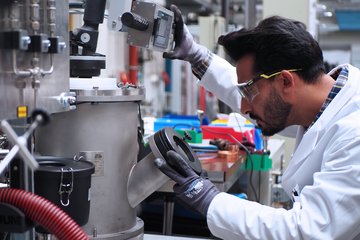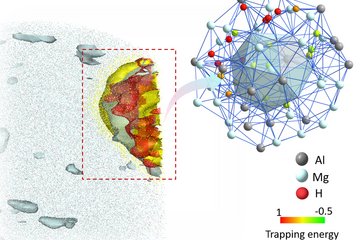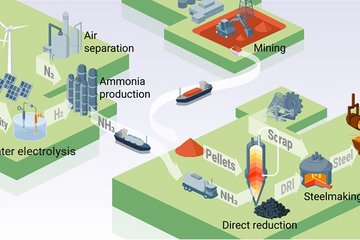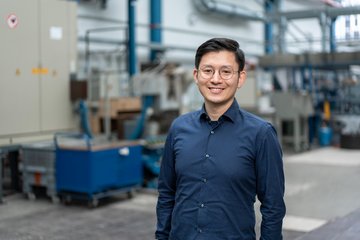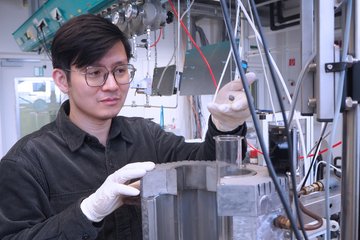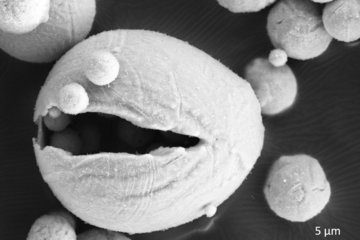Alle Typen
361.
Zeitschriftenartikel
Acoustic Emission during Room Temperature Deformation of a γ-TiAl Based Alloy. Zeitschrift für Metallkunde 90, S. 581 - 587 (1999)
362.
Zeitschriftenartikel
Electron-energy-loss spectroscopy studies of Cu-α-Al2O3 interfaces grown by molecular beam epitaxy. Philosophical Magazine A: Physics of Condensed Matter, Structure, Defects and Mechanical Properties 78 (2), S. 439 - 465 (1998)
363.
Zeitschriftenartikel
Formation and Interface Structure of TiC Particles in Dispersion Strengthened Cu Alloys. Philosophical Magazine A: Physics of Condensed Matter, Structure, Defects and Mechanical Properties 77 (6), S. 1531 - 1554 (1998)
364.
Zeitschriftenartikel
Dispersion Strengthening of Copper Alloys. Zeitschrift für Metallkunde 89 (2), S. 119 - 125 (1998)
365.
Zeitschriftenartikel
Growth and Structure of Internal Cu/Al2O3 and Cu/Ti/Al2O3 Interfaces. Acta Materialia 46 (3), S. 759 - 772 (1998)
366.
Zeitschriftenartikel
Microstructure and Phase Evolution of Niobium-Aluminide-Alumina Composites Prepared by Melt-Infiltration. Physica Status Solidi A 166 (1), S. 241 - 255 (1998)
367.
Zeitschriftenartikel
The Influence of Chromium Addition on the Toughness of γ-Ni/α-Al2O3 Interfaces. Acta Materialia 45 (9), S. 3503 - 3513 (1997)
368.
Zeitschriftenartikel
Synthesis of Analytical and High Resolution Transmission Electron Microscopy to Determine the Interface Structure of Cu/Al2O3. Ultramicroscopy 67 (1-4), S. 207 - 217 (1997)
369.
Zeitschriftenartikel
A microindentation method for estimating interfacial shear strength and its use in studying the influence of titanium transition layers on the interface strength of epitaxial copper films on sapphire. Acta Materialia 45 (2), S. 489 - 499 (1997)
370.
Zeitschriftenartikel
High Temperature Creep of Microcrystalline Dispersion Strengthened Copper Alloys. International Journal of Powder Metallurgy 33 (1), S. 45 - 53 (1997)
371.
Zeitschriftenartikel
Transmission Electron Microscopy at the Max-Planck-Institut für Metallforschung. Zeitschrift für Metallkunde 87 (11), S. 898 - 910 (1996)
372.
Zeitschriftenartikel
Retrieval of Crystal Defect Structures from HREM Images by Simulated Evolution. II. Experimental Image Evaluation. Ultramicroscopy 65 (3-4), S. 217 - 228 (1996)
373.
Zeitschriftenartikel
Quantification of Irradiation Damage Generated During HRTEM with 1250keV Electrons. Ultramicroscopy 63 (1), S. 49 - 55 (1996)
374.
Zeitschriftenartikel
Growth, structure and interfaces of Cu and Cu/Ti thin films on (0001)alpha-Al2O3. Materials Science Forum 207-209 (1), S. 217 - 220 (1996)
375.
Zeitschriftenartikel
Influence of Interfacial Layers on the Ultimate Shear Strength of Copper/Sapphire Interfaces. Materials Science Forum 207-209 (2), S. 597 - 600 (1996)
376.
Zeitschriftenartikel
Electron Energy-Loss Spectroscopy at Cu/Al2O3 and Ti/Al2O3 Interfaces. Materials Science Forum 207-209 (1), S. 181 - 184 (1996)
377.
Zeitschriftenartikel
Measurement of Coherency States of Metal-Ceramic Interfaces by HRTEM Image Processing. Physica Status Solidi A 150 (1), S. 77 - 87 (1995)
378.
Zeitschriftenartikel
Growth and Structure of Copper Thin Films Deposited on (0001) Sapphire by Molecular Beam Epitaxy. Philosophical Magazine B-Physics of Condensed Matter Statistical Mechanics Electronic Optical and Magnetic Properties 71 (6), S. 1111 - 1124 (1995)
379.
Zeitschriftenartikel
Electron Energy-Loss Near-Edge Structure of Metal-Alumina Interfaces. Microscopy Microanalysis Microstructures 6 (1), S. 19 - 31 (1995)
380.
Buch
In-situ Electron Microscopy: Applications in Physics, Chemistry and Materials Science. Wiley VCH Verlag, Weinheim, Germany (2012)
